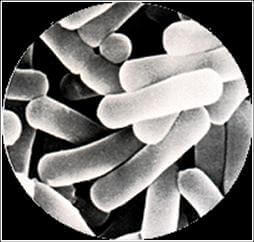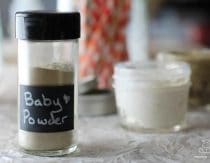
Did you know that the ACTUAL BIRTH EXPERIENCE can affect a child’s cravings . . . for life?
Sounds crazy, I know, but it’s true! The sacred, life-changing, point-your-bum-at-your-mother-in-law-and-push experience is more than we could possibly have imagined. Here’s why:
As far as science knows, babies digestive tracts are sterile while they’re happily bebopping in our tummies.¹ No bacteria. No viruses. No fungi. Nada.
Then labor begins. As babies descend into the birth canal they get their first “meal”: a dose of the microbes/micro-flora living in their mommies you-know, which believe it or not can affect food cravings for life. Okay, altogether now, let’s all shout a collective Ewwwww! There, I feel better. 🙂

Bugs We Love
So what are these micro-flora and why are they so important? Well, in a healthy mother you will see a lot of Lactobacillus species, namely Lactobacillus acidophilus, Lactobacillus casei and Lactobacillus fermentum (plus some bad guys, too in small numbers). These beneficial bacteria perform vital functions within our bodies, such as:
- Digesting and absorbing certain carbohydrates. Without good gut bacteria, your body cannot absorb certain undigested starches, fiber, and sugars. The friendly bacteria in your digestive tract convert these carbohydrates into primary sources of important energy and nutrients.
- Producing vitamins, absorbing minerals and eliminating toxins. Probiotics help in the production of both vitamin K and B vitamins, and promote mineral absorption. They also aid in metabolism and the breakdown of toxins.
- Keeping bad bacteria under control. Simply stated, friendly bacteria compete with the bad guys for room and board, but since beneficial bacteria are more at home there, they win most of the battles for nutrition and attachment sites within your colon.The helpful bacteria also produce a substance that kills harmful microbes.
- Preventing allergies. Friendly bacteria train your immune system to distinguish between pathogens and non-harmful antigens, and to respond appropriately. This important function prevents your immune system from overreacting to non-harmful antigens, which is the genesis of allergies.
- Providing vital support to your immune system. Beneficial bacteria have a lifelong, powerful effect on your gut’s immune system and your systemic immune system as well. The bacteria play a crucial role in the development and operation of the mucosal immune system in your digestive tract. They also aid in the production of antibodies to pathogens.
Bugs We Love . . . To Hate
Wouldn’t it be awesome if we all passed on primarily beneficial bacteria to our children during birth?
Yeah, unfortunately we live in the age of antibiotics, the contraceptive pill, junk food, personal care products and stress, so we’re seeing less of the friendly bacteria these days and more of the dangerous stuff. These pathogens can rapidly colonize the digestive tract of newborn babies, leading to “colic,” digestive disorders, allergies and other problems. And that’s just the beginning . . .
Left unchecked, these pathogenic populations will create holes in the intestinal lining and dump their toxic byproducts along with undigested food into the bloodstream. Depending on the child’s particular vulnerability, this can lead to cognitive problems such as ADD and mood disorders, autoimmune disorders and other neurological problems. According to Dr. Campbell McBride, author of Gut & Psychology Syndrome, individuals with autism, dyslexia, dyspraxia, schizophrenia and other disorders all suffer from gut dysbiosis (a dysfunctional gut).
What Does This Have To Do With Food Cravings?
It’s simple really. When a child”s gut is populated with pathogenic bacteria they lose the ability to digest food properly. Instead of breaking down and traveling throughout the body to nourish cells, it rots in the gut through a process called alcoholic fermentation. As in… beer.
That’s right, improperly digested sugars and refined carbs turn to alcohol in the body while improperly digested grains and milk products can act like opiates such as morphine and heroin. So for example when a child with an overgrowth of Candida (the fungus behind the dreaded thrush) eats a bag of corn chips they’ll feel a surge of “feel good” chemicals as the candida converts the carbs to alcohol. As soon as their little bodies have made the connection between this food and the “feel good” state, it will begin to demand it on a more regular basis, thus beginning a cycle where they crave the very foods that cause them harm (by feeding the bad bacteria which then release opiates/alcohol and other toxins).
It Wasn’t Supposed To Be This Way
Each of us is born with an inner wisdom when it comes to caring for our bodies . . . a gastronomic sage that speaks the language of cravings. As Dr. Campbell McBride puts it,
If your body needs so much protein right now + so much fat + so much carbohydrate + so much of vitamin B12 and so much of vitamin C, how would it let you know that it needs this particular composition of nutrients? And even if your body had a way of letting you know all this information, how would you go about providing this mix of nutrients? How are you to calculate all those factors and provide the right amounts?
Well, Mother Nature is kind and it is not asking us to do anything so complicated. Instead it gave us senses of SMELL, TASTE, DESIRE for a particular food and a sense of SATISFACTION after eating it. So, when your body needs a particular mix of nutrients, it will give you a desire for a particular food, which contains just that right mix; this particular food will smell divine to you and taste wonderful, and you will feel satisfied after eating it.
Our children’s cravings become distorted when pathogenic bugs introduce addictive substances into their bloodstreams, but we can restore balance by replenishing their bodies with healthy bacteria. And that, dear readers, is why my first piece of advice when it comes to nourishing your little ones is:
Let Them Eat BUGS!
I’m talking about beneficial bacteria, of course! Although not a technically one of a baby’s first foods, probiotics lay the foundation what your baby craves for the rest of his or her life. So, what if we had no idea about this when your baby was born? Can it be turned around? Absolutely!
In the next few weeks I’ll be sharing tips for promoting good colonization at birth, plus ideas for overcoming an imperfect start with the little ones we already have!
Do you have a question or topic you’d like me to cover? Leave me a comment below!




